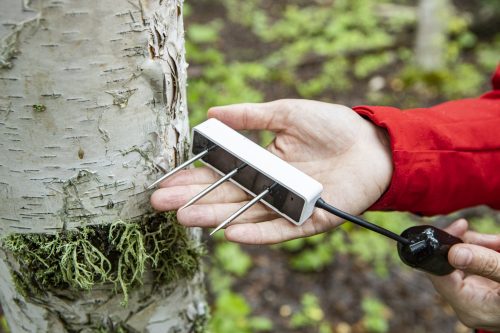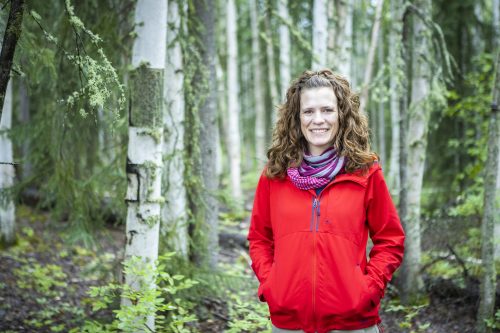UAF research looks for prime time to harvest firewood
August 7, 2019
Debbie Carter
907-474-5406

While studying how trees take up snowmelt and rainwater, Jessie Young-Robertson noticed dramatic seasonal variations in the water content in the trees, particularly in deciduous trees like birch and aspen.
Most of her research was undertaken between March and September, but last year she extended her research through the winter —and made a surprising discovery.
Young-Robertson, a forest ecologist with the University of Alaska Fairbanks, said scientists believed that trees dried down immediately after losing their leaves. However, her sensors in birch trees showed, surprisingly, that the trees dumped 70 percent of their water content into the soil in a 24-hour period in late October. The water dump correlated closely with a drop in temperatures. It happened on one day in which temperatures remained below freezing.
She knew that trees dropped moisture in the fall. “The surprise was how much and how fast,” she said.
The finding could be significant because fall is a popular time to harvest firewood. Depending on when the trees are harvested in the fall, the wood could be very wet or much drier.
Further research is needed, but she believes that the information being collected may hold a key to reducing wintertime air pollution in Fairbanks caused by residents burning green firewood.
“You can let the trees do a lot of the work of drying the wood for you,” she said.
Young-Robertson has studied water uptake in plants for more than 10 years. As part of a National Science Foundation grant, she studied water uptake in several species of trees from March to September for three years. She discovered that deciduous trees have low water content during winter and early spring, become saturated when the snow melts, and lose 20 percent of their water content when they leaf out. Trees refilled their water supply through summer rainfall.

She is trying to pinpoint the time when the moisture content is the lowest and the environmental factors that influence this. If people harvested firewood at the right time, she said, it would shorten the amount of time needed to season it and reduce the fine particulate emissions linked to burning wet wood.
The technology Young-Robertson used to measure the water content in trees has evolved since she started her research in the woods northeast of Fairbanks.
She used to walk or ski to her research plots in the watersheds of Caribou and Poker creeks, off the Steese Highway. She connected a sensor and her laptop to rods attached to the tree to measure its water content. Sometimes electricity conducted by the tree shorted out her sensor, or bands measuring tree girth fell down when the trees shed water. The process is now automated and the devices she uses are more reliable.
Young-Robertson will continue to monitor plots in the research area, but will also establish and follow another plot this fall near Smith Lake. It will include birch, aspen and spruce, collecting data on air temperature, soil temperature, water content and tree girth.
One reason for placing the plot near UAF is that she hopes to stream the data to a website so people can track ongoing conditions and watch for the best time to harvest.
Young-Robertson, a researcher for the Agricultural and Forestry Experiment Station, will expand the project with additional grant money expected this fall. She hopes to increase the number of plots at the research watershed and to add a plot on Fort Wainwright so she can monitor trees in various conditions.

She also hopes to conduct drying experiments with birch and spruce, the two most popular choices for firewood. The firewood would be harvested at different levels of moisture content. She will try to determine the difference in drying times needed to reduce the water content to 20 percent or lower, the standard required by the state and the Fairbanks North Star Borough.
Young-Robertson has many interests besides ecohydrology. She is an artist who paints with vivid acrylic colors and creates art with a digital drawing pad. She is interested in the connections between science and storytelling. She recorded a series of conversations with scientists and others as part of a collaboration with StoryCorps, which airs on National Public Radio. She also told a story about a disastrous solo hike on Kesugi Ridge as part of the Dark Winter Nights storytelling series. She hails originally from New Mexico, where her father worked as a research physicist.
She likes her work with trees and their mysteries. She discovered they conduct electricity when they're full of water and even pick up radio stations. She could detect those signals with specialized sensors and convert them to sound.
“I feel like at every turn, we find something new,” she said.


